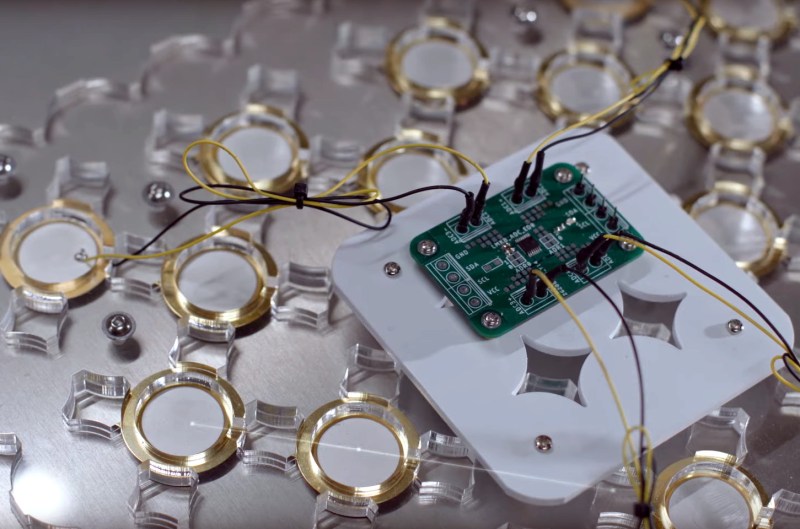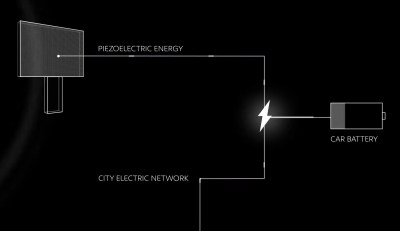Car manufacturers have a problem when it comes to climate change. Among the variety of sources for extra atmospheric CO2 their products are perhaps those most in the public eye, and consequently their marketing departments are resorting to ever more desperate measures to sanctify them with a green aura. Among these are the French marque Peugeot, whose new electric version of their 208 model features in a slick video alongside a futuristic energy-harvesting billboard.
This is no ordinary billboard, nor is it a conventional wind turbine or solar array, instead it harvests ambient noise in one of the busiest parts of Paris, and turns it into electricity to charge the car with an array of piezoelectric energy capture units. This caught our eye here at Hackaday, because it seemed rather too good to be true. Is it a marketing stunt, or could you make a piezo billboard as a practical green energy device? Let’s take a closer look.
What Is Piezoelectricity Anyway?
As most readers will be aware, the pieoelectric effect is a property of some materials by which electric charge accumulates at their surface when they are deformed. In turn a piezoelectric material will also deform when an external electrical charge is applied to it.
There are a variety of piezoelectric substances commonly available including crystaline materials and polymers, and most people will encounter them in domestic applications such as speakers, buzzers, and gas lighters light like that clicky button that ignites your grill. The spark generated by those gas lighters demonstrates that the voltage created by piezoelectric materials can be surprisingly large, but they have by nature an extremely high impedance so they are not generally capable of delivering significant current. Yes, in theory they could be used to generate usable power but it does not appear to a casual observer that they would be an obvious choice. Thus the Peugeot billboard deserves some scrutiny.

We might expect that the billboard would make use of an advanced material, perhaps one of the piezoelectric polymers in a sheet with a large surface area. It’s a surprise then in the video to see that it is instead composed of a large array of the commonly available piezoelectric disk sounders that can be found in a multitude of cheap toys and musical greeting cards. They are held in an array by a lasercut sheet and each one has a small printed circuit board behind it to hold a power connector, feeding its output to another PCB that presumably contains some kind of regulator.
The use of these components really raises an eyebrow. While they will undoubtedly generate some electricity from ambient sound it is definitely not their intended use. There are several reasons for this, and they lie in both the nature of the sound they are facing and their differences from piezoelectric devices intended for energy harvesting.
Carefully-Tuned Energy Harvesting it is Not
Piezoelectric energy harvesters do exist and they can produce usable quantities of power, but to do so they must be distorted slightly, or bent. They are best suited to harvesting energy from constant vibration at a particular frequency, and will normally be chosen and mounted such that they are working close to their resonant frequency of the system they are in.
The cheap piezo sounder disks will also generate electricity if you bend them and also have a resonant frequency, but here they are not being mounted in a way that causes them to do that and are being fed what amounts to a broad spectrum of frequencies rather than a carefully tuned vibration source. Thus it’s unlikely that they are operating at anywhere close to their peak efficiency, which would not have been as high as that of the purpose-built device anyway.

The clinching moment of doubt comes in a fleeting instant of the Peugeot video itself. The whole project is extremely light on technical details, but we do have a glimpse of a block diagram that shows a connection to the city electrical grid. At this point the story becomes clear, this is not a sound-harvesting charge point but a normal mains charge point which can take some input from the sound harvesting panels. Thus it’s safe to declare it a publicity stunt rather than a serious attempt at power harvesting.
This is a shame though, because it remains an interesting project into which its creators have evidently put a significant quantity of work. We doubt that Peugeot will be publishing a full technical write-up of its design, construction, and efficiency, but we think that it wouldn’t do any harm to their image in our community at least (much the opposite, we want to see the data!). Electric cars are still a niche product that has more traction among people with a technical interest, so any of the technology surrounding them will bring plenty of readers.
If there’s a final point to be gleaned from this, it’s that there is a significant quantity of energy contained in ambient sound, so how might it be harvested? Our gut feeling from youthful experiments with high-impedance moving-iron earpieces would take us in the direction of something with a much wider audio bandwidth, but we’re not sure whether an array of surplus 1960s telephone parts would be any more efficient or appropriate than one of cheap greeting-card speakers. We’re sure you’ll have your own views, please feel free to make them known in the comments.
No comments:
Post a Comment